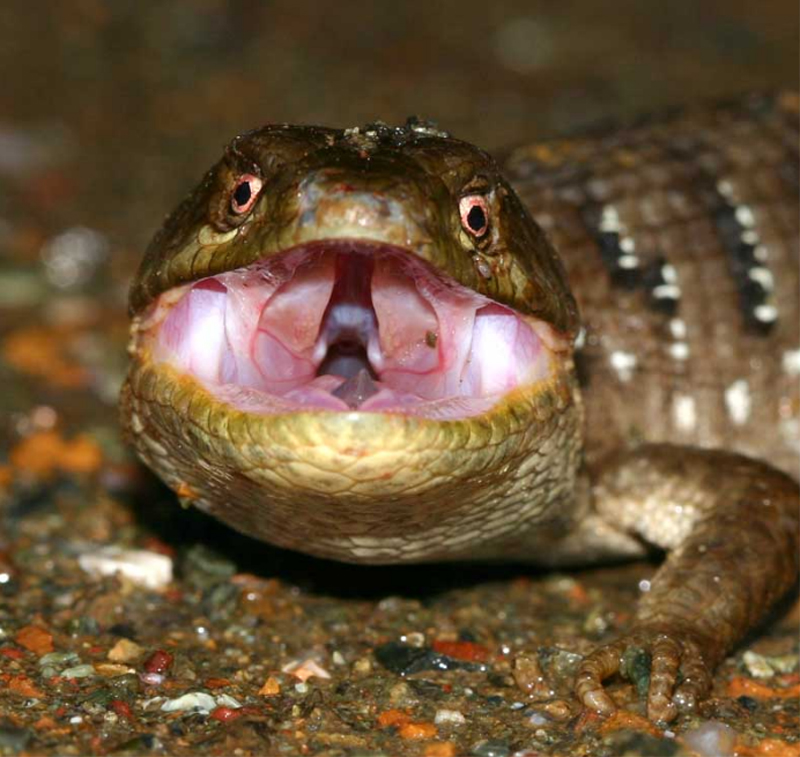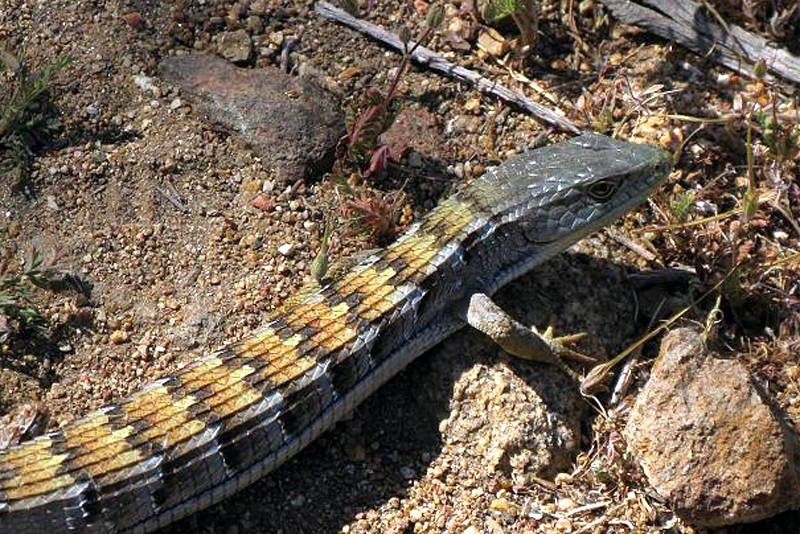 The alligator lizard is certainly smaller than the alligator you might see in the Florida swamps – but it’s still a creature to treat with a certain amount of respect.
The alligator lizard is certainly smaller than the alligator you might see in the Florida swamps – but it’s still a creature to treat with a certain amount of respect.
When alligator lizards are threatened, they will hiss and open their mouth wide, showing a strong row of teeth. You still aren’t backing off? The bite from their strong jaws will be painful, and they might even defecate on you.
Oh, I see. You plan to catch it by the tail? They can shed their tail quickly, and it will be left behind wriggling to distract you while the lizard itself takes cover.
The alligator lizard will grow back a new tail, but it might miss a reproductive season – and it will move more slowly until the tail grows back.
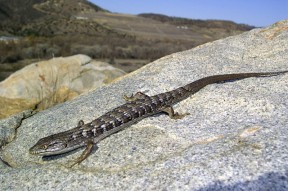 At first glance, they look like a snake, because there is no obvious separation between the body and head, no slimming at the neck, and they move in an undulating, snake-like pattern on the ground.
At first glance, they look like a snake, because there is no obvious separation between the body and head, no slimming at the neck, and they move in an undulating, snake-like pattern on the ground.
Their tail is long, sometimes as much as twice the body length. They are good swimmers, again swimming in a serpentine manner like a snake. They also climb trees easily, using their tail to hold on to branches.
There is little difference between males and females. The male might be slightly larger. The biggest difference is seen in juveniles. They have smooth, shiny scales of different colors, and they are often mistaken for a skink. The adults have overlapping bony plates under the scales.
They have an interesting adaptation: While we wear slacks with an elastic waistband to be more comfortable, alligator lizards are born with a special adaption of a skin fold that goes down each side of their body. If they have a big meal, or they need to breathe deeply, or they’re storing eggs, the fold expands to make them more comfortable.
Our local alligator lizards have yellow eyes, whereas the Northern alligator lizard has dark eyes.
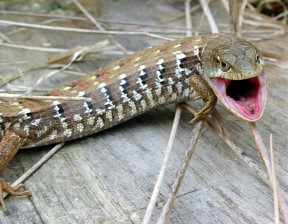 They are quite long-lived, around 15 years. I enjoyed learning that they are “site tenacious,” meaning they are content to live in the same area throughout their lives.
They are quite long-lived, around 15 years. I enjoyed learning that they are “site tenacious,” meaning they are content to live in the same area throughout their lives.
They do not enjoy being in the open; it is too dangerous and hot. They look for cover under wood piles, rocks, debris and plants. Often they will locate a habitat with a certain amount of moisture nearby, like a stream (or our sprinklers).
They shed their skin in one single piece by turning it inside out as they crawl out of it.
Here is a fact that differentiates them from most lizards and snakes: They can be active, grow and digest food even with a body temperature of around 50 degrees. Most other lizards need to be warmer to function properly.
Because they do not have to warm up their body, they have a distinct advantage in hunting prey. They are carnivorous and feed on anything they can catch: insects, larva, spiders, snails, tadpoles – but also other lizards. They can even be cannibals, eating their young or even another alligator lizard. They have a strong appetite and are useful in a garden; one captive adult female consumed 20 grasshoppers, 11 katydids, seven shield bugs, a stink bug and three spiders at a single feeding.
Before they attack their prey, the alligator lizard assesses the situation by moving its head up and down, then side to side to judge distance, and even checks with its forked tongue if possible.
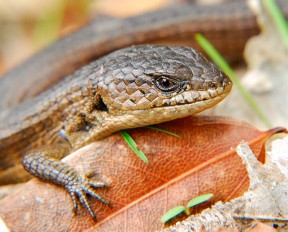 The alligator lizard hibernates underground, and mating happens between April and May. They is little courtship; they just look for a mate. The eggs, between five and 20, are laid in May, June or July and are placed in crevices or rodent burrows. They hatch after 11 weeks, and the juveniles reach sexual maturity when they are 18 months old.
The alligator lizard hibernates underground, and mating happens between April and May. They is little courtship; they just look for a mate. The eggs, between five and 20, are laid in May, June or July and are placed in crevices or rodent burrows. They hatch after 11 weeks, and the juveniles reach sexual maturity when they are 18 months old.
So often I have to end my article by writing that human behavior or interaction is a threat to the wildlife I’m writing about. All of the new housing developments have reduced the habitat of the alligator lizard, but around our suburbs, their worst enemy is the domestic cat. Red-tailed hawks and snakes are also looking to make a meal of them.
You might find them in your garage, where they appreciate the cool shade. Open the door and let them go; you will have fewer black widow spiders to deal with. Don’t be afraid of them, but leave them be. They are a good and useful creature to have in our habitat.
Evelyne Vandersande has been a docent at Placerita Canyon Nature Center for 27 years. She lives in Newhall.
An Alligator in My Backyard | Commentary by Evelyne Vandersande
